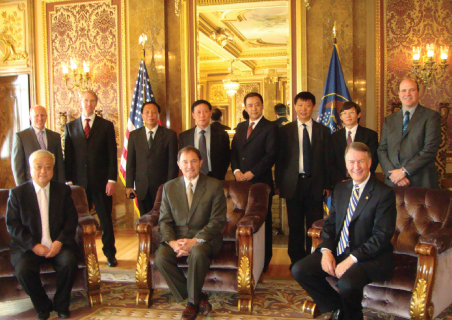By: Dave Guevara and Manish SharmaIssue: Transformation Section: Business
The world is getting smaller—social networking, global media, interdependent economies—and change is happening faster each year. Every company that seeks to be attractive to investors and excel in its industry must also accelerate how fast it adapts to change and creates new growth. A serious threat to achieving sustainable high growth is when senior executives continue to manage with the same techniques that have historically worked, but expect compound annual growth rates to appear somehow. Has your team fallen into the insanity trap of doing the same thing over and over again, and expecting different results?
Creating durable competitive advantage with double-digit growth demands that the senior executive team use creative destruction as a transformational process to evolve their company. However, applied with a broad-brush, whitewash approach, this will fail. The result is often more destruction that creation.
An example is a consumer product company that decimated 8 percent of revenues by prematurely retasking product, service and channel management resources away from a mature market sector. Though the revenue trends from this sector were flat with declining margins, once the customers felt the lack of attention, they immediately found a supplier who wanted its business. The expected earnings from these lost revenues plus the unplanned costs to stem this customer exodus evaporated the current year operating cash flows that were expected to fund the new transformational initiatives.
Avoid insanity by applying three tips for making transformations creative while proactively managing controlled destruction of obsolete processes, systems and management techniques. These three tips are distilled from the wisdom of Ram Charan and Larry Bossidy, authors of Execution–The Discipline of Getting Things Done; Vijay Govindarajan and Clayton Christensen, The Innovator’s Solution–Creating and Sustaining Successful Growth; Warren Buffet’s letters to shareholders; Michael Porter On Competition; and the application of these tips by the authors over the past decade.
Trusted Management Practices Become Obsolete–Keep Principles and Values
Sustainable rapid growth to new performance levels is by its very nature disruptive and transformative. For example, compare two growth plans (see Figure 1) based on compound annual growth rates (CAGR) from a baseline year of $100,000,000 in annual revenues:
1) Double revenues (2X) in 5 years = 14.9 percent CAGR
2) Double revenues (2X) in 3 years = 26.0 percent CAGR
Tracing the red line in Figure 1, the first plan (CAGR = 14.9 percent) calls for as much new revenue in year 5 as the more aggressive plan (CAGR = 26.0 percent) must achieve in the first 12 months. The challenges, practices and skills of the management team of each CAGR example must be fundamentally different to support the challenges summarized in Table 1.
Capability to produce new revenue
• $15M new revenue booked by end of first year, and then improved annually to produce net new incremental growth at the pace of 3 percent/year.
• Year 5 NEW revenues must be 26 percent of the baseline year revenues.
• $26M new revenue capacity must be established in the baseline year or within the 1st quarter of year 1.
• Imagine a start-up creating NEW revenues equal to 1/3 of today’s revenues in year 2.
Capability to sustain existing performance
• By year 3 the company is 51 percent larger and must have been innovated just to retain its current customer base.
• Operational and sales effectiveness must scale to add 15 percent, 20 percent, then 26 percent of new capacity every year—while evolving the established operations to remain competitive and cost effective.
• By year 2 the company is 60 percent larger, must rapidly evolve its current operations to operationalize 33 percent new capacity growth by year 2 and over 60 percent new capacity by year 4.
• Retaining the revenue base while developing new scale and capabilities cannot wait for organizational changes. So the organization has groups who focus on disruptive change, others who specialize in operational effectiveness, and between them teams who can operationalize new capabilities very rapidly.
Innovation Speed
• Disruptive: Market and sales effectiveness will be redefined. Operations, including customer service and management practices, must make a dramatic change by the end of year 4.
• Continuous: Top-down methods for identifying and executing innovation will give way to individual and community-based ideas that are elevated, evaluated, experimented and then executed.
• Disruptive: Becomes almost continuous in parts of the company. This becomes destructive if not insulated from core operations and the established revenue base. One reason for using a new venture approach.
• Continuous: A rapid pace of change becomes the culture of the company. The skill is in changing only where needed, and scaling/evolving most of the current capabilities.
The capability to produce new revenue requires that the new business capabilities, technologies, processes and management practices be established and operational before the beginning of the performance year. This blistering speed of change requires experimentation and adaptation that is characteristic of a new venture, not an established company.
Compounding these challenges are that these new markets, customers, products, services, suppliers, processes and technologies must be operationalized to become mainstream within weeks to months—not years. For most companies this is radically faster than how they achieved their current operational excellence.
Consequently, management practices must shift to focus on managing rapid change where operational processes become adaptive to continuously scale and improve operational performance. In the midst of this change, hold to the core values of the company and the principles, reminding everyone about care for customers, employees, partners and investors.
Transformation Should Be Creative Destruction
Transformation is about learning to be competitively successful at something you have never done before, while preserving the current revenue base until:
• New revenue sources are in place and productive;
• Legacy capabilities can be retired without any or at least acceptable loss;
• An end-of-life transition naturally expires some of the current revenue base;
• It is time to relinquish low-value revenue to competitors.
However, don’t let a “can-do” attitude become a transformational naivety as cautioned by Vijay Govindarajan and Chris Trimble in The Other Side of Innovation: Solving the Execution Challenge. They suggest being realistic about the current operational capabilities and their ability to scale and absorb change while preserving the current revenue base and incremental growth plans. Govindarajan and Trimble describe these current operational capabilities as your “Performance Engine,” and a new team that is chartered with the new, disruptive capabilities as the “Dedicated Team.”
When the pace of change is very high, such as in the CAGR = 26 percent example, then innovation must occur within both the Performance Engine and with a Dedicated Team. As illustrated in Figure 2, the Performance Engine must learn to evolve itself—not 100 percent but the part is needed for new growth—to create a new performance level that is continuously increasing in scale and effectiveness while managing cost optimization.
For management teams that are very good at operational efficiencies and cost containment, this new approach will be frustrating. Change will happen too fast; the usual time from idea to reviewing performance reports will collapse from years to months, months to weeks or even days. Therefore, their focus must shift to systematizing and managing how they optimize and scale operations. This means working through others—usually with much less experience—making systems easy to configure and change, and moving many manual “setup” processes into semi- or fully automated processes.
The Dedicated Team may seem appealing to many because it’s cool and exciting to work on new things. However, these team members and executive sponsors really must possess four key characteristics:
1) Intrepreneurs are very good at finding and vetting new ideas, are comfortable with risk, but also understand how to commercialize these ideas or find sponsorship. They implement new ways of doing business.
2) Change Agents have a unique knack of being able to quickly understand business outcomes and the approaches or options, then identifying the changes that must occur—process, organizational, information, technical, ecosystem. They are masterful communicators in helping others overcome their fears of change, and in seeing themselves in the new reality.
3) Insightful leaders are active listeners and ravenous for information, input, suggestions and alternatives. They quickly formulate a 'story' that establishes vision, purpose and goals; are articulate in communicating that story within the context of any given listener; and can help people know how they contribute toward which outcomes.
4) Operational wizards are those who have already revamped/evolved the Performance Engine, integrated supply chains, or are the ones everyone turns to as advisers/leaders when the “hard stuff” has to get done.
Transformation is a collaborative new culture when done well. Both the Performance Engine(s) and Dedicated Team(s) are responsible to make the new transformational capabilities scalable and the “new” mainstream that will continue to rapidly evolve. Operationalizing new capabilities is critical to making transformations creative. Use three simple principles to mitigate the disruptive risks and destructive effects of these new transformational capabilities:
1) Plan the transitions to be iterative. For example, transitioning part of the Performance Engine to a new Performance Engine, or implementing new products, markets, processes that have never been done before.
2) Define the operating rhythms by perhaps defining two scenarios for different customer adoption rates of the next $20M in new revenue, and what this means operationally in terms of investment, people, processes, systems, supply chains and business partners.
3) Experiment before committing. Formulate your hypothesis, define the success criteria, formulate the experiment, iterate within a time-boxed window, review, get smarter and do what comes next.
Continuous Innovation Must Become Engrained in Your Culture
Transforming your company requires a commitment not just to the new, sexy opportunities, but also to transform your Performance Engine, or build a new one. Transformative initiatives are not a “special project.” Check your readiness by answering, “If you were building a new company from scratch to pursue these transformational innovation initiatives, would you hire people away from your current company, or even acquire it?”
If the answer is “yes,” then your current Performance Engine is ready to scale and absorb the changes from the transformational initiatives. If the answer is “no,” then your initiatives must include transforming your Performance Engine so that it can support these initiatives. One of the common challenges where operational excellence has been high is moving to an iterative, adaptive and “fail fast, often, and fix” culture. This transition is perceived as sacrificing the principles and methods that were critical to achieving operational excellence.
The processes and approach that achieved operational excellence in the first place look much like the approach for commercializing the results from transformational initiatives, such as launching new capabilities, validating results, iterating, relaunching, validating again, iterating again, scaling and expanding, and repeating. The primary difference is a new management and operational skill to define, experiment with and operationalize new innovations must be faster than has ever been done before within the company.
New transformational capabilities should evolve and expand operational excellence continuously and more rapidly while still preserving performance. Consequently, the management skills, processes and principles that created the current operational excellence should evolve and mature, and not be discarded.




















